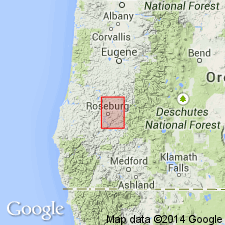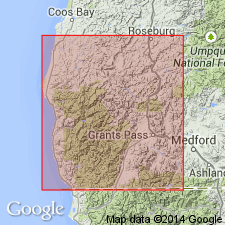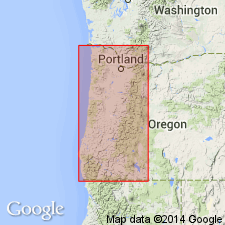
- Usage in publication:
-
- Whitsett limestone lentils
- Modifications:
-
- Original reference
- Dominant lithology:
-
- Limestone
- AAPG geologic province:
-
- Western Columbia basin
Summary:
Whitsett limestone lentils in Myrtle formation. Variegated gray and red foraminferal limestone and marble interbedded in Myrtle formation. One of lentils, 60 feet thick, occurs near J.H. Whitsett's, in secs. 14 and 15, T. 28 S., R. 5 W., Roseburg quadrangle, southwestern Oregon. Age is Early Cretaceous.
Source: US geologic names lexicon (USGS Bull. 896, p. 2328).

- Usage in publication:
-
- Whitsett limestone lentils
- Modifications:
-
- Revised
- AAPG geologic province:
-
- Western Columbia basin
Summary:
Pg. 2778-2780. Whitsett limestone lentils. Some of Diller's Whitsett limestone lentils are included in Riddle formation (new). Lentils are gray to white or locally pink, range from 15 to 60 feet or more in thickness, are thin- to thick-bedded, and may be dense, coarsely crystalline, locally oolitic, or fossiliferous. Most common megafossils are fragments of pelecypods and echinoids. In one lentil exposed in Roberts Creek in secs. 14 and 15, T. 28 S., R. 5 W., James Storr collected fossils that T.W. Stanton identified as OPIS CALIFORNICA Stanton and HOPLITES cf. H. DILLERI Stanton (Diller, 1898). The ammonite appears to be an immature specimen of Portlandian (Uppermost Jurassic) genus BURANGITES. Its presence indicates that at least one of the limestone lentils is middle Portlandian in age. Probably, some clastic beds associated with the limestone lentils likewise belong in Riddle and Days Creek (new) formations. Age problem of Diller's Whitsett lentils is complicated by fact that some lentils contain microfossils of Cenomanian or Turonian age.
Source: US geologic names lexicon (USGS Bull. 1200, p. 4221).

- Usage in publication:
-
- Whitsett Limestone Lentils
- Modifications:
-
- Overview
- AAPG geologic province:
-
- Western Columbia basin
Summary:
zzzzzPg. 49. Whitsett Limestone Lentils. Term does not refer to a single stratigraphic entity, but rather to a particular rock type having a wide range of stratigraphic occurrences. Along Deer Creek in Roseburg-Dixonville area, occur in Portlandian (Upper Jurassic) beds mapped as Riddle Formation by Imlay and others (1959) and as Otter Point Formation by Champ (1969, Univ. Oregon unpub. MS thesis).
Occur in Otter Point and Riddle Formations (Dothan Formation of Wells and Peck, 1961, USGS Misc. Inv. Ser. Map I-325) in Klamath Mountains, southwestern Oregon.
Source: Publication.
- Usage in publication:
-
- Whitsett limestone lentils [informal]
- Modifications:
-
- Overview
GNC Staff, 2008, [U.S. Geologic Names Committee remarks on geologic names, 2008]: U.S. Geological Survey, unpublished Geologic Names Committee note
Summary:
For more information, please contact Nancy Stamm, Geologic Names Committee Secretary.
Asterisk (*) indicates published by U.S. Geological Survey authors.
"No current usage" (†) implies that a name has been abandoned or has fallen into disuse. Former usage and, if known, replacement name given in parentheses ( ).
Slash (/) indicates name conflicts with nomenclatural guidelines (CSN, 1933; ACSN, 1961, 1970; NACSN, 1983, 2005, 2021). May be explained within brackets ([ ]).

